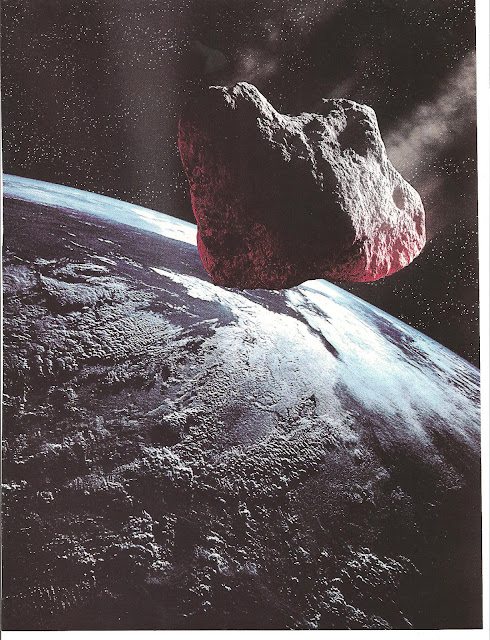- 3684 - METEORS & ASTEROIDS - how many have landed? Most recovered meteorites originated from the Moon or from Mars. Recovering meteorites for astronomers is the next best thing to going there. Meteors themselves are a disappointment because they flash in the night sky and burn up. If is makes it all the way to the surface it is called a “meteorite“. It becomes something for astronomers to study.
---------- 3684 - METEORS & ASTEROIDS - how many have landed?
- Meteorites have been landing on the surface of Earth for millions of years. We have found many of them. You can buy them on E-Bay. In 2004 in Placid, Florida a 5.3 pound asteroid was recovered. E-bay says it came from the planet Mercury so it would yield a higher price. But, astronomers do not think it came from Mercury. They believe it came from the Asteroid Belt.
-
- Each solar system body has distinctive chemical and mineral composition. Using this distinction here are some recent identifications for meteorites:
-
----------------------- 50 meteorites came from the Moon
-
----------------------- 30 ------------------------------ Mars
-
----------------------- 16 ----------------------------- Unknown called “Angrites“.
-
- Moon rocks are rich in “plagioclase” from the highlands and rich in pyroxene and olivine coming from the Maria. We know this because the Apollo program brought back rocks from the Moon. Much of the information on Mars came from the Viking Landers.
-
- The asteroids found in the Antarctica were dated at 1,400,000,000 years old so they probably came from Mars because it took Mars much longer to cool. Asteroids in the Belt cooled and solidified 4,560,000,000 years ago.
- “Angrites” have black and purple grains of pyroxene, a grayish grain of pagodas and greenish grains of olivine. It is rare to find iron-nickel in them. “Plagioclase” means the Angrites formed from volcanic basalt rock like the rock in my backyard. The minerals in Angrites are rich in aluminum, titanium, and calcium, but not iron or magnesium.
-
- The iron in Angrites absorbs visible and infrared light strongly at wavelength of 1,000 nanometers. The surface of Mercury reflects little to no light at 1,000 nanometers suggesting that Mercury is not the source for these Angrites.
-
- The Cosmic Ray exposure detected on Angrites varies from 200,000 to 56,000,000 years. So, that is likely how long they were drifting in outer space. But we are still not positive where these Angrites came from, just not likely to be Mercury.
-
- Why don’t we hear sonic booms when meteor flash overhead? Sometimes you do. However often times the boom reflects off the ground terrain and the interference pattern causes some areas to experience an amplified boom while other areas hear nothing due to the cancellations of the sound wave.
-
- A giant asteroid struck Earth 1,850,000,000 years ago creating the Sudbury Basin in Ontario, Canada. The impact blew a crater in the shallow sea floor that was 160 miles across. Along the seashore were dense colonies of cyan bacteria. Their stumpy masses are call “stromatolites“.
- 470 miles away in Gunflint Lake, Minnesota, a layer cake of these geological deposits was uncovered. Finding dozens of these deposits allowed the geologists to estimate the size of the meteorite to be 6 miles in diameter. The geological deposits contained
½ to ¾ inch green and brown rock spheres.
-
- The Sudbury impact released 6,500 cubic miles of this debris blanketing 1,000,000 square miles.
-
- Geologists have now recorded many of these giant meteorite impacts around the planet. The largest is Vredefort in South Africa. This crater is 2,000,000,000 years old. It is the largest but not the oldest.
-
- The oldest is Suarjarvi crater in Russia. It is 2,400,000,000 years old.
-
- Chiexulub crater in Mexico was 110 miles in diameter and it occurred 65,000,000 years ago. This smaller crater is credited with the demise of the dinosaurs on Earth.
-
- The Sudbury rock re-solidified 1,850,000,000 years ago. Conclusive evidence of these impacts is the shocked quartz mineral grains which are deformed in a destructive manner from the tremendous energy of the impacts. At the time of the Sudbury impact only microscopic cyanobacteria life-forms existed on Earth.
-
- The “cyano-bacteria” are credited with production the free oxygen in Earth’s atmosphere to allow animal life to evolve. It was this oxygenation that caused dissolved iron to precipitate out of the sea water forming massive banded iron deposits on the sea floor. This is the iron ore being mined in Canada today.
-
- The banded iron ore deposits stopped forming around the time of the Sudbury Meteorite impact. It is likely that this impact caused the extinction of the cyanobacteria. Once these bacteria were no longer releasing oxygen then the iron oxide would no longer be produced.
-
September 18, 2022 METEORS & ASTEROIDS 1017 1019 3684
----------------------------------------------------------------------------------------
----- Comments appreciated and Pass it on to whomever is interested. ---
--- Some reviews are at: -------------- http://jdetrick.blogspot.com -----
-- email feedback, corrections, request for copies or Index of all reviews
--- to: ------ jamesdetrick@comcast.net ------ “Jim Detrick” -----------
--------------------- --- Monday, September 19, 2022 ---------------------------

No comments:
Post a Comment